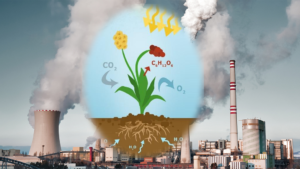Physical Address
23,24,25 & 26, 2nd Floor, Software Technology Park India, Opp: Garware Stadium,MIDC, Chikalthana, Aurangabad, Maharashtra – 431001 India
Physical Address
23,24,25 & 26, 2nd Floor, Software Technology Park India, Opp: Garware Stadium,MIDC, Chikalthana, Aurangabad, Maharashtra – 431001 India

Myth: Rising CO2 Levels Benefit Plants through Carbon Fertilization, So Global Warming Is not as bad as Scientists Proclaim
Why do Plants Need CO2?
Plants are crucial modulators of their environment. Without them, Earth’s atmosphere wouldn’t contain the oxygen we breathe. As we all know, trees use carbon dioxide for photosynthesis, while carbon is an essential primary macronutrient of plants. Some of the carbon is used for plant growth, and some for respiration. Most life on Earth depends on photosynthesis. Let’s take a look at how this process works.
Photosynthesis Process
During photosynthesis, plants take carbon dioxide (CO2) and water (H2O) from the air and soil. The water is oxidised within the plant cell, meaning it loses electrons, while the carbon dioxide is reduced, meaning it gains electrons. This transforms the water into oxygen and the carbon dioxide into glucose.
The plant then releases the oxygen back into the air and stores energy within the glucose molecules. This process continues the growth of the plant along with fulfilling the oxygen requirement of other animals, including humans, in their breathing process.
What is the CO2 Fertilization Effect?
Leaves have small openings called stomata, which open up to absorb CO2 from the atmosphere and open up just long enough to take carbon dioxide. At the same time, it releases water vapours into the atmosphere. This helps to cool the atmosphere. But, when there is more carbon dioxide percentage in the atmosphere, stomata open up for a short time to take carbon dioxide and close very quickly. This quick closure of stomata results in less releasing water vapour and fast uptake of carbon dioxide. This is named as CO2 fertilisation effect. This route retains more water inside the plant and is drained back into the soil.
Rising CO2’s effect on crops’ nutritious value could also harm human health.
“When you grow food at elevated CO2 levels in fields, it becomes less nutritious,” notes Samuel Myers, a principal research scientist in environmental health at Harvard University.
It causes to loss of significant amounts of iron, zinc and protein. Food crops lacking nutritional elements cause protein deficiency in people around the globe.
Do all plants have affected by CO2 Fertilization?
Not all plant species react similarly to an increase in atmospheric CO2 levels. In general, there are two types of plant species such as C3 and C4. Cowpea, cassava, soybean, and rice are some examples of C3 plants and plants like maise , sorghum are known as C4 plants. C3 plants are heavily constrained by atmospheric CO2 levels and are thus expected to display a more substantial carbon fertilisation effect. More can be read here Archived.
Elevated Atmospheric Carbon Dioxide Levels, Thick-Leafed Plants appear to be in Our Future.
Leaves can thicken with the elevated atmospheric carbon dioxide levels, which changes the ratio of surface area to mass in the leaf and alters plant activities like photosynthesis, gas exchange, evaporative cooling and sugar storage.
Scientists, Kovenock and Swann supposed that this critical and predictable leaf-thickening response was an ideal starting point to understand how widespread plant physiology changes will affect Earth’s climate.
Elevated CO2 level threatening Earth’s Cooling Process
Trees perform three primary climate functions they absorb carbon, which they pull from the atmosphere, creating a cooling effect; green leaves absorb light from the sun, heating Earth’s surface; and they draw water from the soil, which evaporates into the atmosphere, creating low clouds that reflect the sun’s hot rays the process known as evapotranspiration that also leads to cooling.
In tropical zones, forests have a significant overall cooling effect. As we experience in Sinharajaya, Kanneliya, the soil is very wet around tropical forests worldwide, and, via evapotranspiration, the trees are covered by low-lying clouds that create a small albedo which is the power of light that is reflected by a surface.
When considering the non-tropical areas, scientist Caldeira explains, “the significant factor is whether there’s snow on the ground in the winter.” If a forest covers a snowy expanse, “that has a strong warming influence,” he further notes, because of little cloud cover resulting from less efficiency in evaporating water. The poor cloud formation, coupled with the intense absorption of light by the trees, “far overwhelms the cooling influence of the carbon storage,” he says.
As well as in the midlatitudes region, it was a wash. The physical impact directly balanced the carbon dioxide effects,” Caldeira says. Read the full article here
Please read this article also, Water Vapor and Its Impact on Greenhouse Gases.
Carbon Sink and Fossil Fuel Burning
Global Biogeochemical Cycles, a Scientific journal report, states, “the global “carbon sink” contributed by plants was less productive, leaving about 5.8 extra petagrams, or 6.39 billion tons, of carbon in the atmosphere per year. Those levels are similar to the amount of carbon released into the atmosphere yearly due to human-generated fossil fuel emissions of eight petagrams, or 8.8 billion tons.” As long as we are out of the way of environmentally friendly policies, we can’t eliminate this problem.
Conclusion
Many research studies into the response of plant life to climate change suggest that most plants will be more stressed and less productive in the future. But there are still many unknowns about the complex interactions between plant physiology and behaviour. There are two sides to everything; in our research study, we got many negative impacts of CO2 fertilisation rather than positive ones. Many factors, including resource availability, the status of the ecosystem, atmospheric conditions and many other factors, will affect overall plant life in the face of climate change.